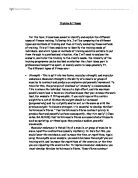Training methods: The ability for our body to overcome a resistance.
There are 4 types of training, circuit, weight, specific and plyometric.
Description: Circuit training is use to improve general and specific strength, it is when a group of 6 to 10 strength exercises that are completed one exercise after another.
Weight training is carried out by using weights, equipment and machines.
Specific strength training includes exercises that are specific to a sport for example add a football to the agility run to make it specific to sport.
Plymometric training this improves strength or speed at which the muscles contract. The muscle is loaded with an eccentric action, followed immediately by a concentric action.
How it works:
By increasing the distance and intensity you increase your strength. The stronger you become the distance and intensity will need to be increased.
Aerobic endurance
Training methods: There are 4 types of training that can be carried out for aerobic endurance these include the following: interval training, fartlek training, continuous training and heart rate training zones.
Description: Interval running enables the athlete to improve the workload by interspersing heavy bouts of periods of fast running with recovery periods of slower jogging. During the run, is produced and a state of is reached. During the interval, the heart and lungs are still stimulated as they try to pay back the debt by supplying oxygen to help break down the lactates.
Fartlek training consists of bursts of speed in the middle of a training session for example a short sprint in the middle of a run or a short sprint whilst cycling. Fartlek gets your legs used to a variety of paces and in the process gives you an enhanced awareness of your ability to keep up those paces at various distances.
Continuous training means the person using 70%-85% of their energy for a long period of time. This means that the athlete’s levels will increase, and it is the way, which the athlete would normally compete. Continuous training is a good way for an athlete to build up their endurance levels.
Heart rate training zones are calculated by taking into consideration your and your Resting Heart Rate.
How it works
Training for aerobic endurance contains high level energy exercises which develop the to meet the demands of the athletes needs.
Speed
Training methods: there are 3 types of training methods for speed these are: hollow sprints, acceleration sprints and interval training.
Description: hollow sprint is when one sprint is separated from the next by a so-called hollow period involving either jogging or walking.
Acceleration sprints are conducted for less than five seconds, with the athletes in a variety of starting positions - lying, sitting, kneeling or standing - depending on the sport.
Interval running enables the athlete to improve the workload by interspersing heavy bouts of periods of fast running with recovery periods of slower jogging.
How it works: the training methods work if you take into account the length of time you are working for and get the pace and rest ratio correct. Increasing work intensity will develop speed.
Muscular endurance
Training methods: there are 4 types of training methods for muscular endurance these include: circuit training, resistance machines, reps and sets and resistance.
Description: The circuit training format involves a group of 6 to 10 strength exercises that are completed one exercise after another. Each exercise is performed for a specified number of repetitions or for a prescribed time before moving on to the next exercise. The exercises within each circuit are separated by brief, timed rest intervals, and each circuit is separated by a longer rest period.
Resistance machines are the pieces of equipment usually found in a gym which incorporate a weight stack and pulley system to provide resistance against a fixed movement.
Between 12 and 15 reps will be needed to help improve muscular endurance
Sets and resistance are needed to improve muscular endurance they need to be carried out at 60-75% maximum effort with 3 – 5 sets.
How it works: by increasing the intensity of work it will improve muscular endurance
Power
Training methods: to train for power sets and reps are used whilst using weights.
Description: 30% of 1RM weights performing 3 sets of 10 reps as fast as possible. 3 or 4 minute rest periods should be taken between each set.
How it works: Maximum power is developed at 30% of maximum speed of contraction and 30% of maximum force contraction.







